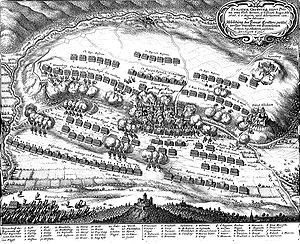Battle of Nördlingen (1645)
| Battle of Nördlingen | |||||||
|---|---|---|---|---|---|---|---|
| Part of Thirty Years' War | |||||||
 |
|||||||
|
|||||||
| Belligerents | |||||||
|
|
|
||||||
| Commanders and leaders | |||||||
|
|
|
||||||
| Strength | |||||||
| 12,000-19,000 | 12,000-16,000 | ||||||
| Casualties and losses | |||||||
| 5,000 | 5,000 | ||||||
The second Battle of Nördlingen (or Battle of Allerheim) was fought on August 3, 1645 southeast of Nördlingen near the village of Alerheim. France and its Protestant German allies defeated the forces of the Holy Roman Empire and its Bavarian Catholic league allies.
The Imperials and the Catholic League were facing increasingly severe pressure in the war from the French, Swedes and their Protestant allies and were struggling to prevent a French attempt to advance into Bavaria.
The 12,000-man Imperial-Bavarian army, led by Field Marshal Franz Baron von Mercy and Johann von Werth entrenched on rising ground near the village of Alerheim, 10 km southeast of Nordlingen. One km to the northeast of the village, the ridge rises to a height called the Wennenberg. Exactly 1 km to the southwest of the village is the Schloss Alerheim, which crowns a hill. Mercy and Werth deployed their right wing on the Wennenberg, anchored their left wing on the schloss (castle) hill, and posted their center on the low ridge between the wings. In the 17th century, Alerheim was smaller and entirely to the northwest of the Imperial battleline between the Wennenberg and the schloss. To protect their weak center, the Bavarian and Imperial officers had some dismounted dragoons and foot soldiers barricade themselves in the village. They hoped to defeat the French by forcing them into a disadvantageous attack uphill into the fire of the Imperial cannon.
Before the battle, Marshal Henri, Vicomte de Turenne united his Franco-German army with an all-French army led by Louis II de Bourbon, Prince de Condé (then known as the Duc d'Enghien, courtesy title of the heir to the Condé honours, to which he would not succeed until the following year). The combined army of 12,000 men was placed under Condé's overall leadership. Condé's tactics were brutally simple. He intended to launch the French troops in a frontal charge on the Imperial positions. Meanwhile, it took the French army from noon until 4:00 pm to arrange its lines for battle.
...
Wikipedia
